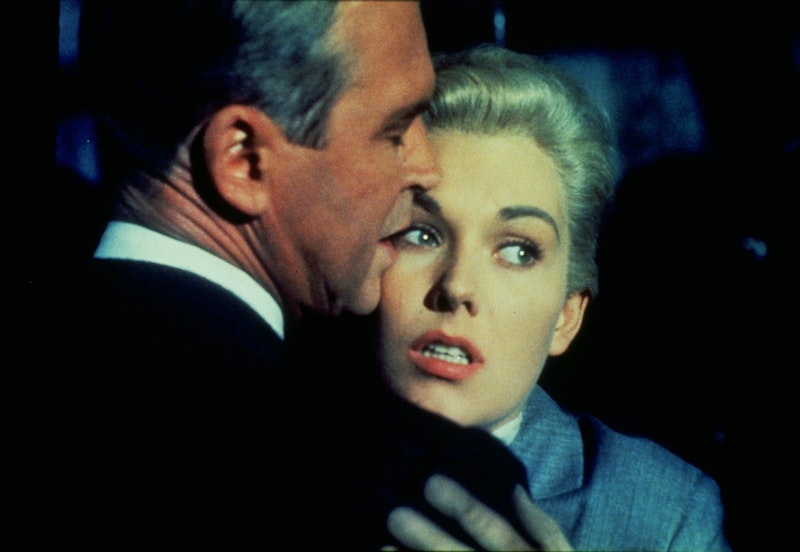Last night, I woke up in the middle of the night, realizing that Bernard Hermann’s musical score for Alfred Hitchcock’s Vertigo (1958) was swirling in my head. At first, the music followed a pattern already established by Hermann. As the sounds of the music unfolded, so did the images of the film. But then, as I lay there in darkness, trying desperately to fall back asleep, the famous score began to jump from one section to the next. Images followed. The amalgam of music and images began to intensify.
My experience of Hermann’s score attests to the fact that the music itself is just as important as the film. The madness that unfolds as we follow James Stewart’s obsession over a woman that never existed, becomes just as disorganized as my middle-of-the-night experience of Hermann’s score.
Stewart plays John “Scottie” Ferguson, a police detective who (at the beginning of the film) nearly falls off the building chasing a criminal. This leaves Scottie with acrophobia, an incredible fear of heights. He’s a fickle man. He’s unattached, but finds his friendship with Midge (Barbara Bel Geddes) pleasant. One gets the impression that Scottie only sees Midge when he feels lonely. In other words, he takes her for granted.
Scottie’s bored and he accepts a proposal by an old college friend, Gavin Elster, to look into a strange behavior of his wife, Madeleine. She’s been obsessed with Carlotta Valdes, a woman long dead, who had a tragic life. In order to find out what exactly Madeleine’s doing on her long drives in San Francisco, Scottie agrees to follow her.
One is wrapped in the mystery but like most of Hitchcock’s films, the mystery’s rarely important. The experience of watching Vertigo can leave one incredibly frustrated. Carlotta Valdes, her alleged suicide, Madeleine’s time in a hotel that used to be Carlotta’s house, even her drive into the sequoia forest are all one big Hitchcock ruse. It turns out to be fake, orchestrated by Gavin Elster himself, whose main objective was to kill his real life, while he hired Judy to play Madeleine. (Both roles are played by Kim Novak, who makes a much better blonde than a redhead.)
Vertigo is a tragic story. Scottie’s in love with “Madeleine,” and when he finds out that the Madeleine that he knew is actually Judy, he becomes obsessed with remaking Judy in Madeleine’s image. Judy submits to it because she loves Scottie but becomes fatigued from his misplaced desires.
In many ways, Vertigo is a Technicolor film noir. Kim Novak’s Madeleine/Judy is both the damsel in distress that desperately needs rescuing and a femme fatale. Scottie’s transported into an ethereal world of fake histories, fake personalities, and fake deaths. But Novak’s Madeleine is hardly a self-made femme fatale. She’s a woman at the mercy of two men: Gavin Elster and Scottie.
Madeleine/Judy is owned, but her personal sovereignty had more strength under the influence of Elster than Scottie. With Elster, there was an understanding of transaction. Of course, she didn’t count falling in love with Scottie. Nevertheless, Elster’s hold is temporary, but Scottie who is supposed to be one of the “good guys” reveals himself to be a man of severe anxieties.
His good friend Midge tries to alleviate the insecurities but fails. Scottie doesn’t seem interested in a bespectacled designer. The mystery of Madeleine and the possibility of going over the edge in more ways than one are the two things on Scottie’s mind. He’s not truly in love with her but with an image that turns him into a wounded madman. Stewart’s Scottie is hypnotized by a dead woman who never existed but who has the power in the film?
In his conversations with François Truffaut, Hitchcock stated, “Cinematically, all of Stewart’s efforts to recreate the dead woman are shown in such a way that he seems to be trying to undress her…” Scottie’s interested in a different kind of nudity, and not simple nakedness. He forces himself on Judy by demanding that she look exactly like Madeleine. He wants more and more, and isn’t satisfied until Judy becomes Madeleine, once again. She’s trapped by Scottie’s obsessions, anxieties, and nightmares. Essentially, Scottie’s demanding that Judy remove her own face and put on a mask of Madeleine—a non-existent entity. She’s a mere player in this staged love of madness, a plaything meant to satisfy a morbid desire to unite with a dead woman.
Vertigo’s a suspenseful and mysterious film but not for the usual or straightforward reasons. The revelation that Gavin Elster killed his wife and hired Judy to impersonate her is almost of no consequence (at least cinematically speaking). The real mystery of Vertigo is the darkness that resides in human heart. It’s the mystery of Being—morbid understanding of love, and the tension between the masculine and feminine desires. It’s only tragedy that emerges from the unsettled heart.

